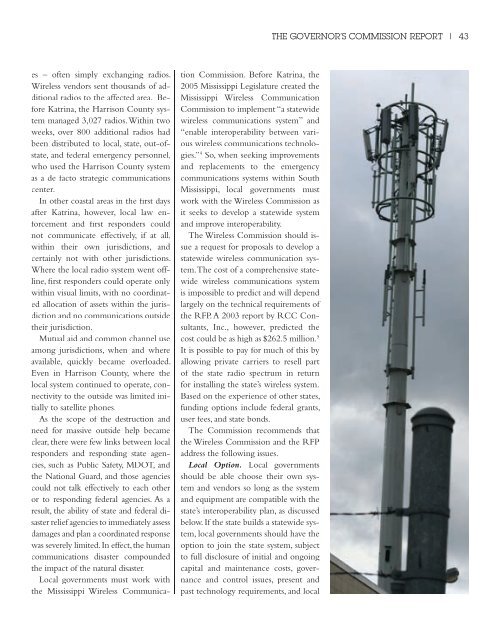Reports - Mississippi Renewal
Reports - Mississippi Renewal
Reports - Mississippi Renewal
- No tags were found...
You also want an ePaper? Increase the reach of your titles
YUMPU automatically turns print PDFs into web optimized ePapers that Google loves.
THE GOVERNOR’S COMMISSION REPORT | 43es – often simply exchanging radios.Wireless vendors sent thousands of additionalradios to the affected area. BeforeKatrina, the Harrison County systemmanaged 3,027 radios. Within twoweeks, over 800 additional radios hadbeen distributed to local, state, out-ofstate,and federal emergency personnel,who used the Harrison County systemas a de facto strategic communicationscenter.In other coastal areas in the first daysafter Katrina, however, local law enforcementand first responders couldnot communicate effectively, if at all,within their own jurisdictions, andcertainly not with other jurisdictions.Where the local radio system went offline,first responders could operate onlywithin visual limits, with no coordinatedallocation of assets within the jurisdictionand no communications outsidetheir jurisdiction.Mutual aid and common channel useamong jurisdictions, when and whereavailable, quickly became overloaded.Even in Harrison County, where thelocal system continued to operate, connectivityto the outside was limited initiallyto satellite phones.As the scope of the destruction andneed for massive outside help becameclear, there were few links between localresponders and responding state agencies,such as Public Safety, MDOT, andthe National Guard, and those agenciescould not talk effectively to each otheror to responding federal agencies. As aresult, the ability of state and federal disasterrelief agencies to immediately assessdamages and plan a coordinated responsewas severely limited. In effect, the humancommunications disaster compoundedthe impact of the natural disaster.Local governments must work withthe <strong>Mississippi</strong> Wireless CommunicationCommission. Before Katrina, the2005 <strong>Mississippi</strong> Legislature created the<strong>Mississippi</strong> Wireless CommunicationCommission to implement “a statewidewireless communications system” and“enable interoperability between variouswireless communications technologies.”4 So, when seeking improvementsand replacements to the emergencycommunications systems within South<strong>Mississippi</strong>, local governments mustwork with the Wireless Commission asit seeks to develop a statewide systemand improve interoperability.The Wireless Commission should issuea request for proposals to develop astatewide wireless communication system.The cost of a comprehensive statewidewireless communications systemis impossible to predict and will dependlargely on the technical requirements ofthe RFP. A 2003 report by RCC Consultants,Inc., however, predicted thecost could be as high as $262.5 million. 5It is possible to pay for much of this byallowing private carriers to resell partof the state radio spectrum in returnfor installing the state’s wireless system.Based on the experience of other states,funding options include federal grants,user fees, and state bonds.The Commission recommends thatthe Wireless Commission and the RFPaddress the following issues.Local Option. Local governmentsshould be able choose their own systemand vendors so long as the systemand equipment are compatible with thestate’s interoperability plan, as discussedbelow. If the state builds a statewide system,local governments should have theoption to join the state system, subjectto full disclosure of initial and ongoingcapital and maintenance costs, governanceand control issues, present andpast technology requirements, and local




